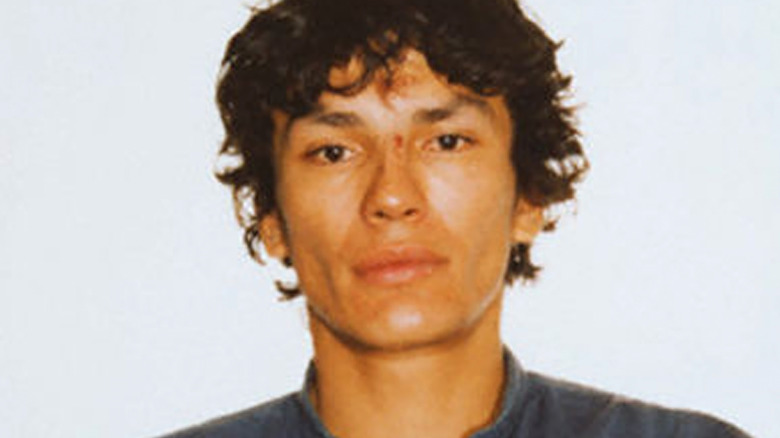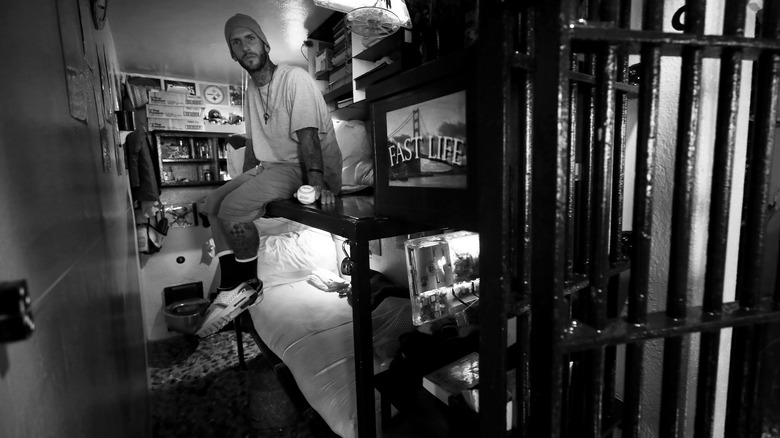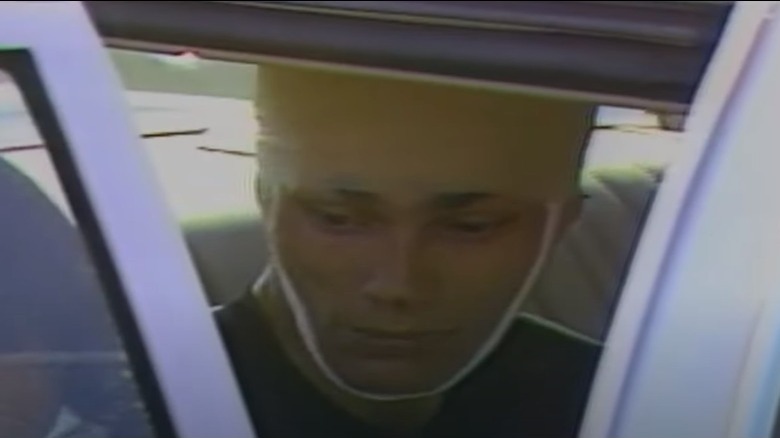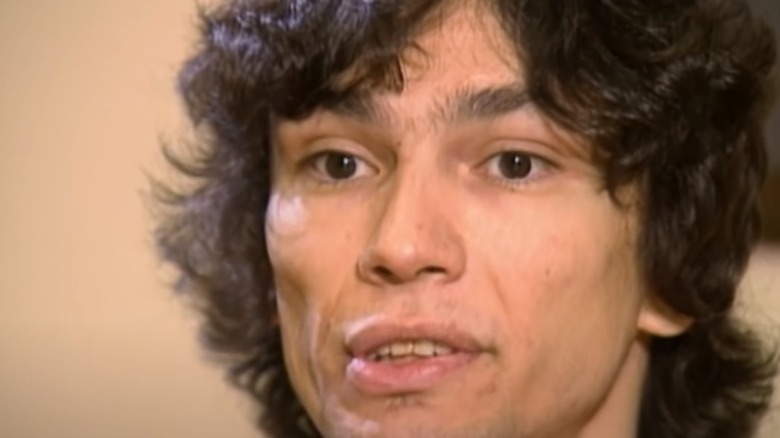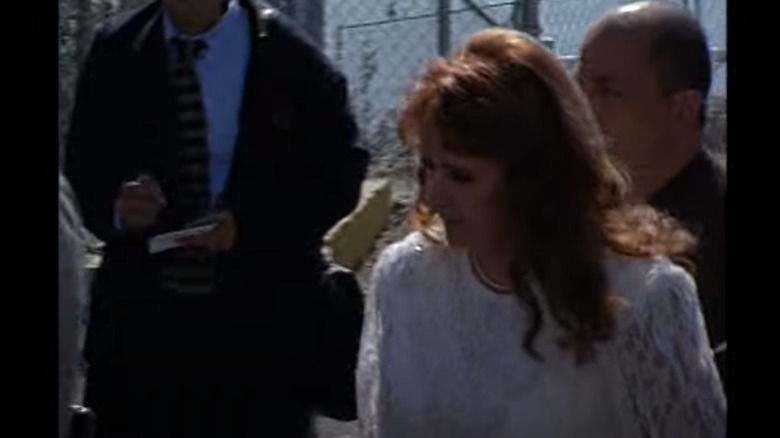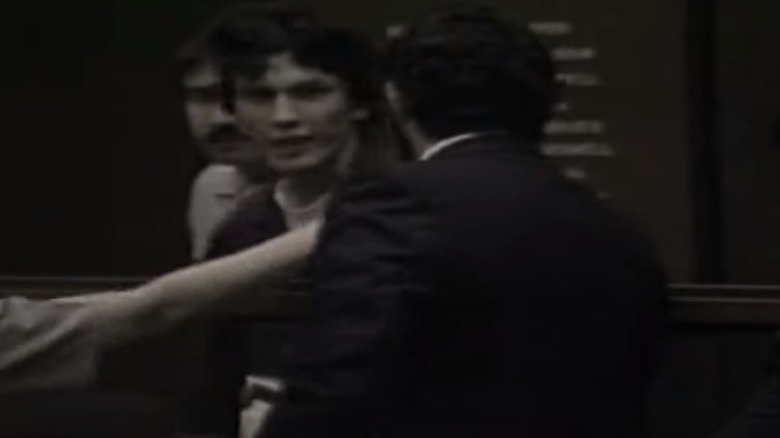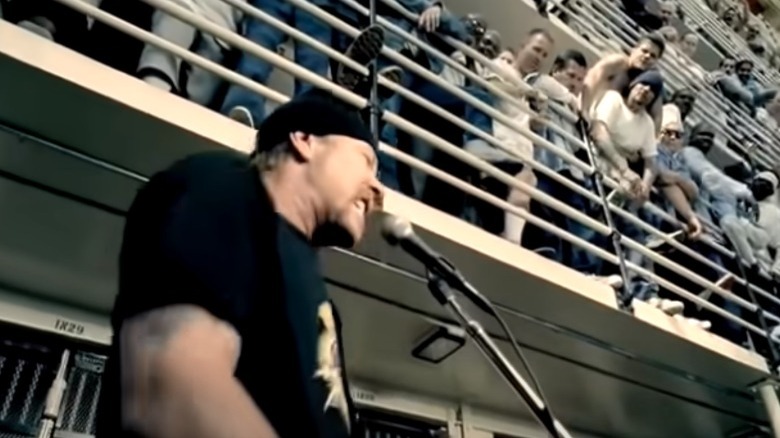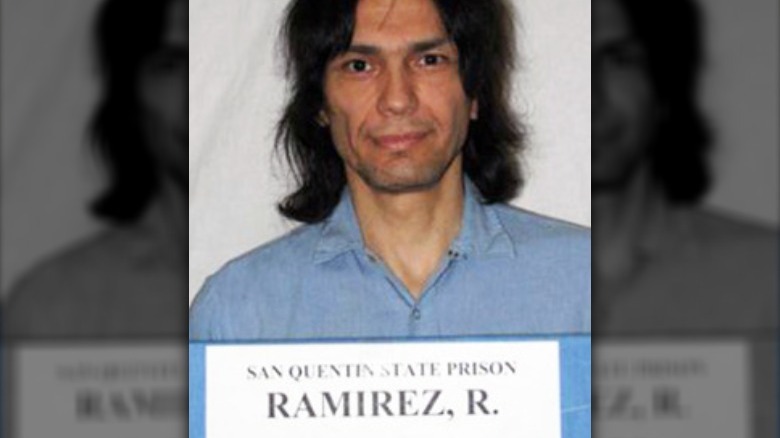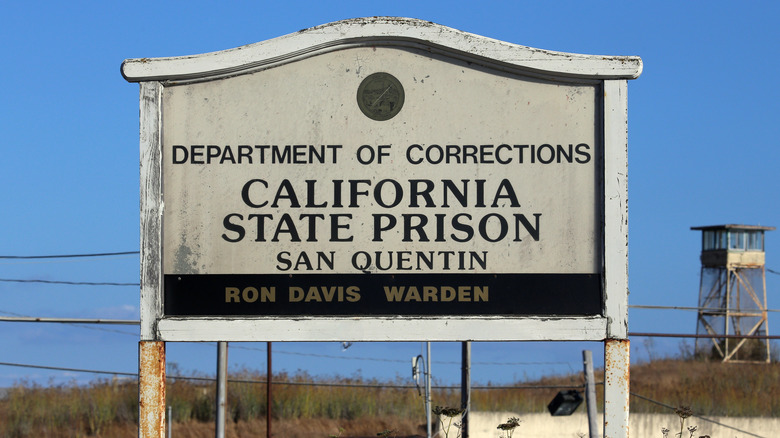What Richard Ramirez's Life In Prison Was Really Like
Summertime. California. The mid-1980s. It should have been a scene of kids on their bikes, arcades, boardwalks, and long days when the curfew was dictated by when the streetlights came on. Instead, those living in Southern California were gripped with a terror that came in the night, killing indiscriminately. He had a few different names, but CBS reports that when he was finally captured, the one that he preferred was the one that stuck: the Night Stalker.
His real name was Richard Ramirez.
What unfolded during the trial was terrifying, starting with tales of a childhood shaped by relatives who returned from Vietnam to show the young boy photos of gruesome horrors. A lifetime of abuse — and another family member who was tried and convicted of murder — all built up to Ramirez's first kill: a 9-year-old girl. She was far from the only child among his victims, and one survivor of a brutal sexual assault would ultimately be responsible for giving police a description of her attacker, then bravely picking him out of a line-up. She was 6 years old, and when law enforcement asked her if she had any questions, she simply asked, "Do I write the word 'two' or the number '2'?"
Should his sentence — execution — have been carried out? Did he deserve to live a life behind bars? And what, exactly, was that life like?
Richard Ramirez was sentenced to death and held at San Quentin
It's unknown just how many people Richard Ramirez tortured, assaulted, and killed. It was, after all, only in 2009 that the Los Angeles Times reported that DNA evidence had connected him to a brutal cold case. The remains of a little girl named Mei Leung were discovered on Apr. 10, 1984, and the case was ultimately closed by the same officer who had been assigned to it early in her career. Police Inspector Holly Pera explained, "It's the type of case — as a new officer, a involving a little girl — that you can't forget."
By the time he was captured, Richard Ramirez would kill at least 14 people, according to Biography, and be connected to a series of sexual assaults that were so unthinkable that he was handed the death penalty. Even his trial was bloody: One of the jurors was murdered before the conclusion of the proceedings. Still, it wrapped up with a unanimous decision. Ramirez was found guilty on all 43 charges against him, and wasn't just sentenced to death; he was sentenced to death 19 times. While he was waiting for his sentence to be carried out — and his appeals to go through — he was held at California's San Quentin State Prison.
Ramirez spent the rest of his life on death row. In 2013, he died — but not in the gas chamber, as he was sentenced to. The official cause of his death was complications from B-cell lymphoma.
What outsiders have seen of death row
San Quentin has housed death row prisoners for a long time. According to Britannica, the state's first official execution took place there in 1893. It's a history that came to an end in 2022, when the Los Angeles Times reported that death row was being dismantled. They were allowed inside to photograph the prison.
To get to their cells, prisoners are escorted up the center of a walkway. Yellow lines prevent anyone from getting too close to the cells, and those cells? They stretch up on either side, a tall, multi-level block with bars outside of the walkways, stretching up to the roof. Cells are narrow and painted beige, with inmates given a single thin mattress on a solid bunk. In 2016, KQED News was taken inside to interview some of the hundreds of inmates being held there, and got a clearer look at the cells where those condemned to death spent much of each day.
Time spent outside was largely restricted to cells, too, with some inmates getting their fresh air while confined to cages little bigger than their interior cells. Some played basketball in other confined areas, all under the watchful eye of armed guards. One inmate interviewed by KQED, Charles Ray Smith, spoke about one of the constants: "They can come get you and execute you. It's always on your mind, it's always in the back of your head." At the time, there were 746 inmates being held on San Quentin's death row.
Richard Ramirez had a tendency to show people way more than they wanted to see
Lt. Sam Robinson was a spokesperson for San Quentin at the time of Richard Ramirez's death in 2013, and he made it clear to NBC that Ramirez was no less of a monster behind bars.
There was one thing in particular that he liked doing: Whether it was a visitor, a guard, or another staff member, he would masturbate in front of them. Robinson explained to The Daily Beast that he had a tendency to expose himself in front of children, and after a 2004 incident involving a young girl who was visiting someone else, his interaction with others was severely restricted. "All of his visits were behind a partition. He wasn't allowed to touch someone or hug them. ... He would also expose himself inside the housing unit to guards. We put signs in front of the cell saying he has the propensity to do that."
Shelly Ramirez is the niece of the notorious serial killer, and after his death, she spoke out about what a relief it was. She was only 7 years old when he was sent to San Quentin — but as an adult, she did visit him there. Afterwards, she sought counseling to help her deal with the incident. She confirmed that he had masturbated during their visit, and he condemned her for wearing a gold cross. "I felt really, really dirty and gross," she said. "I never had contact with him again."
He got a ton of fan mail — and answered it
As strange as it sounds, Richard Ramirez was ridiculously popular. While he was on trial, he leaned hard into the whole Satanic, child-of-darkness thing, at one point saying, "Legions of the night — night breed — repeat not the errors of the Night Stalker and show no mercy. I will be avenged."
And here's the thing — people were fascinated by it. Scott A. Bonn, Ph.D., wrote (via Psychology Today) that Ramirez's gruesome celebrity continued after he was convicted. He spent a lot of his prison time responding to his fan mail and corresponding with the scores of people who wrote to him. They were mostly women, and he once explained, "I think the girls are attracted to me because they can relate to me. The girls are nice when you're in my situation, but since I'm in here I spend more time writing to them about the relationship, rather than living it, but there are good friendships formed nevertheless."
When Ramirez died in 2013, San Quentin spokesperson Lt. Sam Robinson spoke with NBC about his death — and a little bit about what his life had been like. When he'd arrived, Robinson said, he'd kept up that larger-than-life, rock star-style personality. That gradually faded as the years dragged on, but Robinson said that one thing that was consistent was the amount of fan mail he received — the most of any inmate on death row.
Yes, he had his teeth fixed in prison
Photos of Richard Ramirez just after his arrest and those later in life are drastically different for one huge reason: his teeth. They're important, and not just for cosmetic reasons.
As A&E recounts, Ramirez had missing and decaying teeth, which were mentioned repeatedly by victims who often described the man who had attacked them — and oftentimes murdered their loved ones. Police knew early on that they were looking for someone who had shaggy black hair and terrible teeth. They were instrumental evidence as well: A trip to the dentist put him in the area where the murders took place, disproving testimony from Ramirez's family claiming he was with them.
But later pictures of Ramirez show him sporting some pearly whites, and according to True Crime Magazine, it took a lot of work. They claim it took Dr. Alfred Otero — a dentist associated with the Los Angeles Sheriff's Department — a whopping nine months to fix Ramirez's teeth. Some were filled with compounds, he had one root canal done, and severe decay — caused by a lifetime of not brushing, eating sugary foods, and using cocaine — was fixed.
He got special visits from one of the jurors who convicted him
Cindy Haden was one of the jurors from Richard Ramirez's trial, and when one of her fellow jurors was killed in 1989, she told the Los Angeles Times, "My first thought was that we were all going to be picked off one by one. Who's next?"
When she later appeared on "Geraldo," she had something else on her mind. When asked if she cared for Ramirez, she responded, "Yes, I do. That's just one side of him. ... Everybody has a dreadful side." On the phone was the daughter of Ramirez's 10th and 11th official victims, and she described in detail what had been done to her parents. Haden's response to her heartbreaking story was, "I look beyond that. I look at what's behind that: Why?"
Haden went on to say that even though she was one of the unanimous voices who convicted him, she believed he didn't get a fair trial and spent many of her days visiting him in jail. Haden said they talked about her and her life, and she added that he was spending much of his time trying to understand himself and why he had done the things that he did. According to History Collection, she could spend so much time with Ramirez because she had gotten her private investigator's license to allow her to accompany his defense team on visits — and yes, she had gotten some alone time with the killer she convicted.
Women were throwing themselves at Richard Ramirez
Richard Ramirez never failed to attract fangirls. In 1990, KRON 4 interviewed some who showed up at his trial. When asked why they were there, one (pictured, left) replied, "I just wanted to see what he looks like. I think he's cute."
In 1991, the El Paso Times reported that there were hundreds of women who lined up for their chance to go behind bars to visit — and security was, at the time, shockingly lax. Not only did visitors not even have to share their names, but conversations weren't monitored or recorded. Sgt. Rich Dyer of the San Francisco Sheriff's Department explained, "They just ask for the prisoner they want to see and when it's Ramirez, he always does see them. ... Their conversations aren't monitored, so we don't know what they talk about. ... A lot of them appear to be women who have never met him, but some have come back to visit some more."
In those early days of his incarceration, Ramirez met with an average of around eight to 10 women a week — and oftentimes, those who went to see him were turned away simply because there wasn't enough time for them all. SFGate spoke to one, who declined to be identified. She explained: "He is good-looking, and I loved his big hands. The thrill of danger of going up to a state penitentiary made it all worth it because to me, it was like a dream come true to face one of the world's most feared men."
He married one of his groupies
Richard Ramirez found a bride among the flocks of women who went to see him, and that, says Marie Claire, was Doreen Lioy. They married while Ramirez was sitting on death row, a 1996 wedding that happened a few years after Lioy started sending him letters then going to visit him — a connection that started just after his conviction. The Los Angeles Times was on hand to interview her, saying she went to see him about four times a week and noting that she was careful to always bring breath mints so she could "kiss with confidence."
The year after they tied the knot, Lioy told CNN, "He's kind, he's funny, he's charming. I think he's really a great person. He's my best friend, he's my buddy." She explained how she was sure he was innocent, and how she was willing to suffer the loneliness of being married to a man on death row if it meant she was with him ... but things seem to have changed.
When The New York Times ran a story on Ramirez's death, they mentioned Lioy, but no divorce. However, San Quentin spokesperson Lt. Sam Robinson told The Daily Beast that he had no visitors in the years leading up to his death, while The Sun suggests she stopped seeing him in 2009, after he was concretely tied to the murder of 9-year-old Mei Leung.
He had planned several escape attempts
A few months after Richard Ramirez died on death row, the New York Post spoke to an anonymous source who described Ramirez's feelings about being locked up: "Being incarcerated went against everything Ramirez was about. He hated being cooped up in a cell, but he valued his freedom to roam the streets and kill."
They say that the first time he tried to put an escape plan into motion was on September 21, 1993. He was traveling between San Quentin and a San Francisco court to face charges there, and when he was scanned with a handheld metal detector, it went off. Guards found that he had inserted a syringe, a ballpoint pen, a handcuff key, and a sticker into his rectal cavity. (The sticker read, "I luv chocolate.") Why? Who knows. That's not to say he didn't have a plan, though, as he was reportedly going to fake an illness to get sent to a hospital — which typically had much less security than the prison.
The second time didn't occur until 1998, and was reportedly a less complete plan by the time it was discovered. Authorities were apparently alerted to the possibility there was something in the works when one of his many fan letters hinted at the fact that the sender was helping him to plot an escape. She had just visited him, and was immediately put on a restricted list denying her access.
Richard Ramirez was outraged when he missed a Metallica concert
Prison concerts are a thing: Famously, Johnny Cash performed at San Quentin in 1959 (via The Boot), and he definitely wasn't the only one. In 2003, Rolling Stone says that Metallica headed inside San Quentin for a 10-song concert for the prison inmates, including — perhaps surprisingly — songs from their 1984 album "Ride the Lightning."
James Hetfield was pretty straightforward about how hesitant he'd been to perform there, and one thing that story didn't mention is that Richard Ramirez was apparently a massive Metallica fan. Does it seem unfair that someone on death row could get a front-row seat to Metallica? Yes? Good news!
Kirk Hammett spoke with NME in 2022, and confirmed that Ramirez was a Metallica fan — he knew because he'd been given Ramirez's personal copy of a magazine with the band on the cover. According to the guards, Ramirez had been able to hear the concert from his cell on death row, and he'd been so outraged that he hadn't been allowed to go that he had spent the whole time pacing back and forth. Hammett recalled, "He hung out in Richmond, California, and I wonder sometimes if me and the guys [from his earlier band] were at the same parties as him back in the day."
He was eventually allowed limited contact with other inmates, and a few visitors
Richard Ramirez was sent to San Quentin in 1989 and was still being held there when he died in 2013. According to what prison spokesperson Lt. Sam Robinson told The Daily Beast, the final years of his life were lonely ones.
His access to other inmates — and particularly, their visitors — was severely restricted in 2004, when he exposed himself to a young girl in the visitor's room. Although his privileges were returned at some point, they were revoked again in 2007 and by 2010, he had lost the privilege of having any personal visits whatsoever. Even after his visiting privileges were again restored, Ramirez, said Robinson, started refusing all visitors — and that made for some solitary days. Not only was he not allowed visitation, but he wasn't allowed to come in contact with any other inmates on death row. That contact had ended sometime around 2000, when a fight — reportedly started by him — broke out in the yard.
So, how did he spend most of the hours of his final days? Alone, in his cell, with only his television for company.
The drug use that contributed to his death happened pre-conviction
After Richard Ramirez died in 2013, the New York Post spoke with a source who had reportedly seen him in his last days on earth. "He was the color green. He looked like a green highlighter pen. He was sitting up in his bed doing stretches."
That's not unheard of. In 2002, a paper by the Washington Hospital Center looked at another instance of a person turning bright green, with a cause that was linked to multiple organ failure. Ramirez was taken to the hospital, and after he died, his autopsy revealed a cocktail of illnesses. The one that killed him was B-cell lymphoma, reported USA Today. The Marin County coroner also found he was suffering from hepatitis C and complications from chronic substance abuse, which was clarified by assistant chief deputy coroner Lt. Keith Boyd: "That's chronic drug use prior to incarceration. There's nothing to support any kind of drug use while incarcerated." As for the hepatitis C, Boyd concluded that, "It's likely something that he has been dealing with for years."
Ramirez wasn't executed, but he still died on death row. According to KQED News, that's not super uncommon. When they looked at the stats in 2016, they found that since 1978, the state had executed 13 inmates from death row, while another 69 had died of natural causes. Ramirez was one of them.
